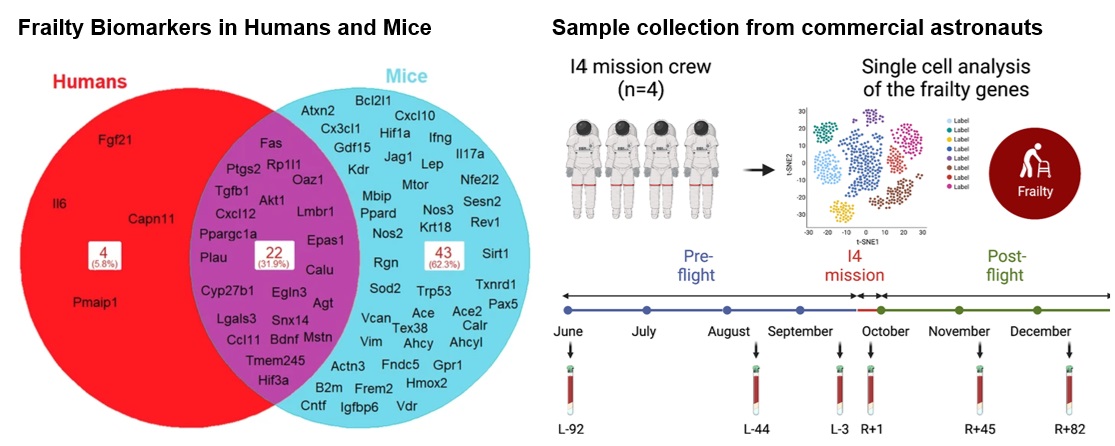Aging and Fragility Biomarkers are Altered by Spaceflight
Spaceflight accelerates the symptoms of aging in astronaut bodies by inducing genomic instability, mitochondrial dysfunction, and increased inflammation. This is the first study to comprehensively examine biomarkers and pathways associated with spaceflight and terrestrial aging, frailty, and sarcopenia. Main Findings: Impact: This work reveals the need for a frailty index to monitor development of frailty-related […]


Figure Left: Venn diagram of differentially expressed frailty genes in rodent and human samples shows the common differentially expressed genes between the two species.
Figure Right: Schematic of the Inspiration4 experiments and samples.
This study relied on data from the OSDR, including 7 rodent spaceflight datasets, 2 human space analog datasets, astronaut data from the Japan Aerospace Exploration Agency (JAXA) and Inspiration4. Data on sarcopenia were mined from National Center for Biotechnology Information’s Gene Expression Omnibus.
Spaceflight accelerates the symptoms of aging in astronaut bodies by inducing genomic instability, mitochondrial dysfunction, and increased inflammation. This is the first study to comprehensively examine biomarkers and pathways associated with spaceflight and terrestrial aging, frailty, and sarcopenia.
Main Findings:
- Spaceflight induced notable changes in gene expression patterns related to frailty and muscle loss indicative of a frailty-like condition.
- Exposure to the space environment leads to changes related to inflammation, muscle wasting, and other age-related features observed in both mice and humans.
- Parallels between spaceflight and the aging process may extend to also encompass frailty.
Impact: This work reveals the need for a frailty index to monitor development of frailty-related astronaut health risks during spaceflight. The results provide insights into potential avenues for developing countermeasures to combat frailty-related health risks for both astronauts and aging populations on Earth.
This study was part of the 44-article Space Omics and Medical Atlas (SOMA) package published in Nature. It demonstrates the effectiveness of open science combined with robust data submission, standards, and curation. The study began within and was organized through the Analysis Working Groups (AWGs) of NASA’s Open Science Data Repository (OSDR).







